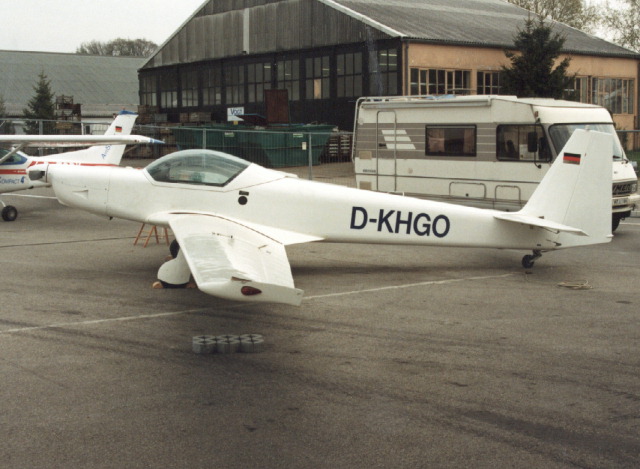Самолеты Фурнье
<...>
Последующие разработки самолетов семейства RF-6 уже шли под обозначением компании "Slingsby", а линейка самолетов Фурнье пополнилась моделями RF-9 (выпускалась в Германии компанией "Gomolzig") и RF-10 (выпускалась во Франции компанией "Aerostructure" и в Бразилии компанией "Aeromot" под обозначением Ximango).
Показать полностьюShow all
Aerostructure (Fournier) RF-10
RF-10, впервые взлетевший 6 марта 1981 года, был разработан во Франции конструктором Рене Фурнье как последний в своей серии мотопланеров и сверхлегких летательных аппаратов. Он был создан на основе принципов классических планеров. В целом аналогичный RF-9, RF-10 конструктивно выполнен полностью из композиционных материалов с углепластиковым главным лонжероном и модернизированной силовой установкой с двигателем Limbach L 2000 Е01 с четырьмя горизонтально расположенными цилиндрами мощностью 80 л. с. (59,6 кВт). После постройки второго опытного образца "Fournier" продала права на RF-10"Aerostructure SARL", которая запустила его в производство с Т-образным хвостовым оперением вместо низкорасположенного, как было у опытных образцов. Первый серийный RF-10 взлетел 10 мая 1984 года, всего было построено около 12 самолетов. Четыре приобрели португальские ВВС для 802-й эскадрильи Академии ВВС в Синтре. Они использовались военнослужащими для проведения одиночных, самостоятельных вылетов во время прохождения тренировочных курсов пилотирования. Впоследствии весь пакет прав приобрела фирма "Aeromot" из Порто-Алегре (Бразилия), где модель была усовершенствована и выпускалась как серия Aeromot Ximango.
ТАКТИКО-ТЕХНИЧЕСКИЕ ХАРАКТЕРИСТИКИ
Aerostructure (Fournier) RF-10
Тип: двухместный мотопланер и учебный самолет для первоначальной подготовки
Силовая установка: один поршневой двигатель Limbach L 2000 Е01 с четырьмя горизонтально расположенными цилиндрами мощностью 80 л. с. (59,6 кВт)
Летные характеристики: максимальная крейсерская скорость 200 км/ч на оптимальной высоте; экономичная крейсерская скорость 180 км/ч на оптимальной высоте; максимальная скорость планирования 245 км/ч при спокойном воздухе и 180 км/ч в условиях турбулентности; начальная скорость набора высоты 150 м в минуту
Масса: пустого 600 кг; максимальная взлетная 800 кг
Размеры: размах крыла 17,47 м; ; длина 7,75 м; высота 2,70 м; площадь крыла 15 м2
Показать полностьюShow all
M.Hardy. Gliders & Sailplanes of the world
Fournier RF-9
Designed by M Rene Fournier, the RF-9 is basically a side-by-side two-seater development of his earlier Avion-Planeur RF4D and RF5 which were manufactured in Germany under licence by Sportavia Putzer. After the latter was formed in 1966 M Fournier remained active as an independent designer, later forming the Fournier Design Office and Avions Fournier SA, which produced the RF-6B two-seat light aerobatic trainer and sporting type. The latter company went bankrupt in 1977 not long after the first prototype RF-9 had made its maiden flight on 20 January that year, and while the first production aircraft was being built. The second prototype, which is representative of production aircraft, has a lighter undercarriage, new air brakes and trailing edge flaps. Avions Fournier SA was succeeded in the spring of 1978 by Fournier Aviation, formed by the marine equipment specialist Rene Caillet of Paris, and M Fournier now acts as consultant to this firm. The RF-9 motor glider is intended for training and is of conventional all-wood construction; the cantilever low wings have dihedral from the roots and on the prototype differ from the RF4D's and RF5's in having electrically-actuated trailing edge flaps as well as air brakes in the upper surfaces. The outer part of each wing can be folded inward for easier hangarage, and has connect/disconnect aileron controls. The semi-monocoque fuselage is broadly similar to the RF4D's with a polyester skin, but it is cut down behind the one-piece cockpit canopy, which opens upwards and rearwards and gives exceptional visibility. Full dual control is provided. The tail unit is similar to the RF4D's, with a small dorsal fin. Instead of the monowheel and outriggers of the RF4D and RF5, the RF-9 has a conventional inwards-retracting under carriage and a steerable tailwheel, also retractable. The engine is a 68hp Limbach SL 1700E 'flat four' driving a Hoffmann two-blade fixed-pitch propeller; a variable-pitch prop from the same manufacturer can be fitted if required, as can VHF radio and oxygen equipment. The fuel capacity is 6.6 Imp gallons.
Span: 55 ft 9 1/2 in
Length: 25 ft 3 in
Height: 6 ft 0 in
Wing area: 193.75 sq ft
Aspect ratio: 16.0
Empty weight: 1,168 lb
Max weight: 1,653 lb
Max speed: 119 mph
Max cruising speed: 99 mph
Min sinking speed: 2.56 ft/sec at 50 mph
Best glide ratio: 28:1 at 62 mph
Take-off run: 328 ft
Range: 324 miles
Fournier RF-10
The RF-10 two-seat motor glider is a development of the RF-9 but primarily of glassfibre instead of wooden construction, as the latter is now considered too expensive in labour costs. It has a wing built in four sections and incorporating some carbon-fibre components, as well as folding capability for easier hangar storage. Engine is an 80hp Limbach L2000 or - for customers in the United States - an 80hp Revmaster with turbocharger and dual ignition. Fuel capacity is increased over the RF-9's to 8.8 Imp gallons, and the mainwheels are larger. The prototype RF-10 first flew in the spring of 1981 and production was due to start by September. One RF10 has been ordered for a projected London-Australia record flight in 1982.
Span: 57 ft 0 in
Length: 26 ft 0 in
Empty weight: 1,168 lb
Min sinking speed: 2.6 ft/sec at 50 mph
Показать полностьюShow all






